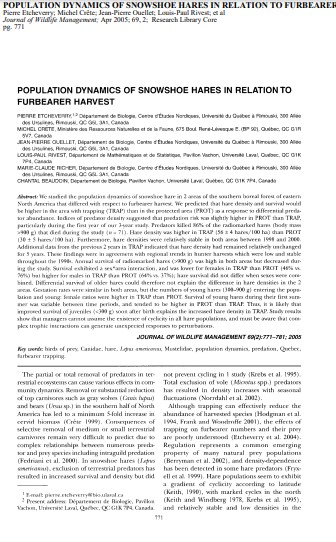Population dynamics of snowshoe hares in relation to furbearer harvest
Bosque Modelo:
Bas-Saint-Laurent
Temática:
Conservación
Tipo de documento:
Artículo científico
Resumen
We studied the population dynamics of snowshoe hare in 2 areas of the southern boreal forest of eastern North America that differed with respect to furbearer harvest. We predicted that hare density and survival would be higher in the area with trapping (TRAP) than in the protected area (PROT) as a response to differential predator abundance. Indices of predator density suggested that predation risk was slightly higher in PROT than TRAP, particularly during the first year of our 3year study. Predators killed 86% of the radiomarked hares (body mass >900 g) that died during the study (7 = 71). Hare density was higher in TRAP (56 + 4 hares/100 ha) than PROT (30 + 5 hares/100 ha). Furthermore, hare densities were relatively stable in both areas between 1998 and 2000. Additional data from the previous 2 years in TRAP indicated that hare density had remained relatively unchanged for 5 years. These findings were in agreement with regional trends in hunter harvests which were low and stable throughout the 19905. Annual survival of radiomarked hares (>900 g) was high in both areas but decreased during the study. Survival exhibited a sex*area interaction, and was lower for females in TRAP than PROT (46% vs. 76%) but higher for males in TRAP than PROT (64% vs. 37%); hare survival did not differ when sexes were combined. Differential survival of older hares could therefore not explain the difference in hare densities in the 2 arcas. Gestation rates were similar in both areas, but the numbers of young hares (300-900 g) entering the population and young: female ratios were higher in TRAP than PROT. Survival of young hares during their first summer was variable between time periods, and tended to be higher in PROT than TRAP, Thus, it is likely that improved survival of juveniles (<300 g) soon after birth explains the increased hare density in TRAP. Study results show that managers cannot assume the existence of cvelicity in all hare populations, and must be aware that complex trophic interactions can generate unexpected responses to perturbations.
Información Bibliográfica
Autor:
Etcheverry, P, M Crête, J-P Quellet, L-P Rivest, M-C Richerand C Beaudoin.
Revista:
Journal of Wildlife Management
Año:
2005
N°:
2
País :
Canadá
Páginas:
771 - 781
Volumen:
69
Idioma:
Ingles
Palabras claves
birds of prey, Canidae, hare, Lepus amencamus, Mustelidae, population dynamics, predation, Quebec, furbearer trapping.





